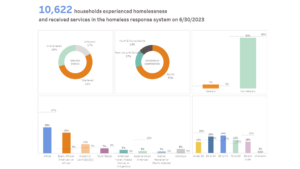UPDATE: Dec 17, 2021. The federal Dept. of Housing & Urban Development (HUD) has granted KCRHA a methodological exception to the traditional PIT Count. The RHA will conduct (1) a sheltered count as usual, (2) qualitative research in March 2022, (3) an unsheltered count built into the qualitiative engagement. In addition, the RHA will rely on King County integrated administrative data finding 40,000+ people experiencing homelessless.
The federal Dept. of Housing & Urban Development (HUD) requires a Point In Time (“PIT”) Count of people living unsheltered to be conducted every two years in order to receive federal funding. But, the PIT is widely understood to be an undercount, especially in suburban and rural communities. Recognizing that, the RHA will not be conducting the traditional, volunteer-driven PIT Count of unsheltered people this coming January. Instead, we will conduct qualitative engagements with people living unsheltered, and we are developing that research plan in collaboration with the Lived Experience Coalition, service providers, and stakeholders across King County.
Q: Why aren’t you conducting the PIT Count this January?
Because of the methodology, the PIT is widely understood to be an undercount, which can be harmful in skewing the narrative and limiting the budget and resources dedicated to solutions. Instead, we will conduct qualitative engagement with people living unsheltered to learn more about their experiences and how we can better meet their needs.
In addition to qualitative engagement, KCRHA is working with data partners to explore other ways of collecting a more accurate number of people experiencing homelessness, including development of a By Name List.
Q: Is the PIT Count required by the U.S. Dept. of Housing & Urban Development (HUD)?
Yes, every other year. While King County has traditionally performed an unsheltered count as part of the PIT every year, unsheltered counts are only required by HUD every other year. King County, like most Continuum of Care agencies, received a federal waiver for the January 2021 unsheltered PIT Count because of COVID. Upon HUD approval, King County may use a different methodology in 2022. [Updated per November HUD guidance.]
Q: What is the PIT Count methodology? Why is it an undercount?
The Point-In-Time Count relies on volunteers to spread out across the county on one night in January and hand count the number of people that they physically see living unsheltered, multiplied by a number that’s meant to estimate the people they didn’t see (such as people in abandoned buildings), which is then added to the number of sheltered people reported in HMIS and surveys of shelter providers.
Because it relies on what volunteers see during a few hours in the early morning, in a neighborhood that may be unfamiliar to them, recorded on a paper tally sheet, at a time when there could be heavy rain or cold, there are many ways for data to be missed.
Q: If the PIT Count is so inaccurate, why does HUD require it?
By default and without an alternative, the PIT Count is the only regular national count of people experiencing homelessness in the U.S., and has become a part of the regulatory environment in order to receive federal funding.
Fun fact: The PIT Count has been required since 2005, which is two years before the first iPhone was released.
Q: How many people were living unsheltered in King County according to the last PIT Count?
The last PIT Count in January 2020 found 11,751 people experiencing homelessness in King County (53% sheltered and 47% unsheltered), and the 2020 Census found 15,419 people living in “other non-institutional facilities,” which includes both sheltered and unsheltered.
We believe the actual number to be much larger.
Q: Who usually manages the PIT Count?
The Count is usually volunteer-driven, and in the past has been organized by SKCCH, All Home (the predecessor to KCRHA), and service providers. Under COVID constraints and with both the RHA and service providers currently understaffed, organizing a PIT Count at this time would be burdensome, and could lead to an even more inaccurate count.
Rather than rely on a volunteer undercount at a time when the RHA is still in start-up, we decided to focus on pulling more accurate data from the systems we have, scoping out what’s needed for a By Name List, and gathering qualitative data about what people are experiencing. That information will be more useful in redesigning our system around what people need.
Q: We rely on the PIT Count for advocacy and to raise awareness. If you don’t do the count, how will we build awareness and advocate for investments in homeless response?
Because the PIT is an undercount, especially in suburban and rural communities, it can have a negative effect on advocacy by skewing the narrative and leading to under-resourcing. Instead, KCRHA is working with data partners to explore other ways of collecting a more accurate number of people experiencing homelessness, including development of a By Name List. Together with our qualitative information, we will have a much clearer picture of who is living homeless, where they are and what they need—which will allow us to advocate for solutions at the right size and scale to make a difference.
Q: Will you do the PIT Count next year (in 2023)?
Yes, if required by HUD in order to receive federal funding, the RHA will conduct a count of people living unsheltered at a Point-In-Time in January 2023.
HUD does allow regions to develop their own data collection approaches. We plan on using the next year to take a critical look at how we can improve the PIT in our community, including how we might combine the count with other data sources for a more illustrative snapshot of homelessness in our region. Although the PIT Count alone does not fully capture the number or experiences of those living unsheltered, especially in suburban and rural communities, it is one data point that can be combined with data to gain a better understanding of homelessness in our community.
Q: Why do you want qualitative data? What will you do with it?
The RHA is committed to a customer-centered approach, and that means listening to our customers directly. The only way to build a system that is responsive to what people need is to ask them what they need.
Q: How will the qualitative engagement work?
We are developing the research plan in collaboration with the LEC, service providers, and stakeholders across King County. Our current best thinking is that we will carry out a multi-modal qualitative engagement, including surveys, interviews, and focus groups. This qualitative engagement will likely include a headcount that meets HUD requirements [updated per November guidance]. These tools would be deployed over several months to ensure we get high levels of participation across the county.


